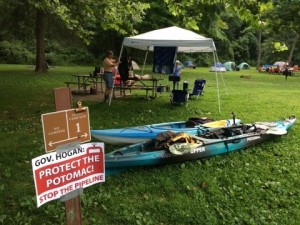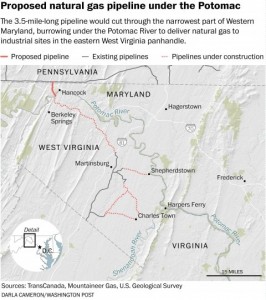From an Article by Patricia Sullivan, Washington Post, August 6, 2017
HANCOCK, MD — Activists with the Potomac Riverkeeper Network set up at Paw Paw Tunnel Campground near Oldtown, Md., for a weekend paddle and protest over TransCanada’s planned natural gas pipeline.
The pipeline that TransCanada wants to build is short, 3.5 miles, cutting through the narrowest part of Maryland. It would duck briefly under the Potomac River at this 1,500-resident town, bringing what business leaders say is much-needed natural gas to the eastern panhandle of West Virginia.
But environmentalists say that brief stretch could jeopardize the water supply for about 6 million people, including most of the Washington-metropolitan area.
That’s why dozens of protesters have gathered each weekend this summer at various points along the upper Potomac, part of a growing national movement that opposes both oil and natural gas pipelines and wants businesses and governments to embrace green energy instead.
Inspired by the Dakota Access oil pipeline protest at Standing Rock, N.D., and the broad wave of demonstrations that has energized the left since President Trump’s inauguration, the protesters hope to persuade Maryland Gov. Larry Hogan (R) and his environment secretary to stop the pipeline, which got an enthusiastic green light from West Virginia.
“It’s got me worried,” said Andy Billotti, 53, who wore a T-shirt from April’s Peoples Climate March in Washington as he erected his tent at the Paw Paw Tunnel Campground near Oldtown, Md., for one recent protest. “If something were to happen, that fracked poison would come down the river . . . right into our wells.”
Opponents gathered at the McCoys Ferry campsite in Clear Spring, Md., over the weekend and will be at Taylors Landing next weekend. The protest at Taylors Landing, near Sharpsburg, Md., is slated to include state Sen. Richard S. Madaleno Jr. (D-Montgomery), a gubernatorial candidate and the latest of a handful of politicians to take part.
The activists want Hogan, who this year banned fracking in Maryland, to deny TransCanada a water quality permit to cross the Potomac. Environment Secretary Ben Grumbles said the state has sought additional information about the project from the company and will schedule a public hearing on the permit application in coming weeks.
About 40 other permits are also needed, including ones from the Federal Energy Regulatory Commission and the National Park Service, because the pipeline would also go under the C&O Canal.
Industry and economic development officials say the pipeline is safe and sorely needed to attract new employers to the West Virginia panhandle.
“There are hundreds, if not thousands, of miles of gas lines like this in the Washington, D.C., area,” Eric Lewis, president of the Jefferson County Development Authority (JCDA), told about 60 protesters in July at a town council meeting in Shepherdstown, W.Va. “If people have issues with fracking, they should take it up somewhere else.”
West Virginia’s Public Service Commission already granted its utility, Mountaineer Gas, approval to begin building the distribution pipeline from Berkeley Springs to Martinsburg. Bulldozers are at work. The utility plans to eventually extend that line to Charles Town and Shepherdstown.
The natural gas that runs through the area’s existing pipeline is entirely spoken for since the opening of a Procter & Gamble manufacturing plant near Martinsburg, Mountaineer Gas officials said.
“You’ve got to have an industrial base to provide employment,” said West Virginia Commerce Secretary H. Wood Thrasher. “Without gas service, we are dead in the water.” He said the state has lost a “significant” number of companies interested in moving to the eastern panhandle because of the lack of natural gas service.
The JCDA has been working on getting natural gas service to the region for “decades,” said John Reisenweber, the authority’s executive director. More recently, it has encouraged the development of renewable green energy, such as wind and solar. But manufacturers, commercial and some residential developers insist on natural gas, he said.
While gas pipelines have crisscrossed the country since the 1920s, the number of approved interstate lines has spiked in recent years, driven by the boom in natural gas extraction through hydraulic fracturing. Protests have spiked, too.
New Yorkers convinced their state environmental agency twice in the past two years to deny a water quality certificate for natural gas pipelines. Federal authorities shut down a much-criticized Ohio pipeline in May, after 18 leaks spilled more than 2 million gallons of drilling fluid, adversely impacting the water quality. Catholic nuns near Lancaster, Pa., have built an outdoor chapel in an attempt to stop another pipeline.
In Virginia, two disputes over much larger proposed pipelines have become a hot-button political issue in the governor’s race.
The nation’s 2.3 million-mile pipeline network is considered the safest way to move oil, and the only feasible way to transport natural gas. Natural gas pipeline leaks are down 94 percent since 1984, the industry says. But accidents do happen — an average of 299 significant incidents in each of the past five years, according to federal data.
TransCanada spokesman Scott Castleman noted that his company and its predecessors have a century of experience in the region. The proposed eight-inch diameter pipeline would be buried up to 100 feet beneath the riverbed, with walls twice as thick as required, and constant monitoring for leaks and surges. A dozen TransCanada pipelines safely cross the Potomac River elsewhere in Maryland, Castleman said.
“More and more, people realize that each of these [pipeline] projects deepens our commitment to fossil fuels, locking us in for 40 or 50 more years,” said Bill McKibben, a well-known environmentalist and author. “The scientific verdict on natural gas has changed, and changed dramatically, in the past half-decade.”
The major component in natural gas is methane, which is significantly more efficient at trapping heat — and warming the planet — than carbon dioxide. A study published last year by Harvard University researchers found that emissions from methane have increased significantly since fracking began, although the researchers said they could not readily attribute the increase to fracking.
Members and friends of the Potomac Riverkeeper Network attended the July paddle to raise awareness about the pipeline project. Environmentalists also point to the geology of the upper Potomac. The land beneath the river in this region is karst, a term for a terrain that is full of fractures, caves and pools, where special precautions are needed when building pipelines to avoid spillage of chemicals or gas into the water supply.
“Unless you have an X-ray of the ground, you never know where the water goes, or where it comes from,” said Stephanie Siemek, a doctoral student at the University of Maryland Center for Environmental Science’s Appalachian Laboratory in Frostburg, Md., who led a tour of the Paw Paw Tunnel for the environmentalists camping nearby in July. “You don’t know how old it is, or where it’s derived. It might start from a mountaintop, but we don’t know how it gets to a spring.”



{ 2 comments… read them below or add one }
Controversial Sunoco Pipeline Spills Drilling Fluid Three Times in Same Area
By Lorraine Chow, EcoWatch.com, October 8, 2017
Sunoco Pipeline Spills Drilling Fluid Three Times in Same Area
Sunoco’s controversial Mariner East 2 pipeline project has racked up even more spills.
Pennsylvania’s Daily Local News reported that horizontal directional drilling triggered three releases of drilling fluid around the same site in East Goshen over the span of three days.
The “small inadvertent returns”—an industry term for spills—happened twice on Monday and another on Saturday, Sunoco communications manager Jeff Shields said in the report. He added that drilling stopped, the fluid has been contained, and no water resources were affected.
The latest spills add to a track record of leaks and other incidents surrounding the $2.5 billion pipeline project that’s designed to carry 275,000 barrels a day of butane, propane and other liquid fossil fuels from Ohio and West Virginia, across Pennsylvania, to the Atlantic coast.
In July, a judge ordered Sunoco to temporarily halt horizontal directional drilling for installation of its Mariner East 2 pipeline, siding with environmental groups that the process caused dozens of drilling fluid spills and other accidents between April and mid-June, including leaks into wetlands and waterways. The order expired Aug. 7.
Sam Rubin, organizer with Food & Water Watch, gave the following statement to the Daily Local News:
“Sunoco is a dangerous operator. The one person who can take immediate action to keep our community safe is Gov. Tom Wolf. Gov. Wolf has not lived up to his statutory responsibility to prepare the state of Pennsylvania for the risks of a high pressure ethane pipeline in densely populated areas. We need a full, publicly available and comprehensive safety and preparedness analysis done. Gov. Wolf needs to halt this pipeline until one is complete.
Today’s leak adds to the proof, which was already abundantly clear, that Sunoco cannot be trusted to operate in a safe manner. There have already been over 100 reported spills and other drilling accidents linked to the construction of the Mariner East 2 pipeline. We don’t need any more evidence.”
The Daily Local News suggested that the company may have to stop drilling at the site until it receives approval to resume operations in light of a settlement agreement brokered between Sunoco, the PA-DEP and the Clean Air Council, which stated:
“If the inadvertent return is confirmed to be less than 50 gallons and is the first inadvertent return at an HDD location, HDD operations may continue after containment is achieved and removal of the inadvertent return has been completed, following approval by PADEP or the County Conservation District … if the inadvertent return is 50 gallons or greater, or of unknown quantity, or is a second or subsequent inadvertent return at an HDD location, drilling operations will be suspended until PADEP inspects the site, concludes that further drilling will not result in additional returns of 50 gallons or greater, and approves a restart of drilling operations.”
Source: https://www.ecowatch.com/sunoco-pipeline-spill-2495544214.html?utm_source=EcoWatch%2BList&utm_campaign=57eed89aca-EMAIL_CAMPAIGN&utm_medium=email&utm_term=0_49c7d43dc9-57eed89aca-85323945
Letter to the editor, Hagerstown Herald-Mail, February 16, 2019
Pipeline and Water Protection Act needed in Maryland
To the editor:
Thank you for your coverage of the Pipeline and Water Protection Act, recently introduced in the Maryland General Assembly. This bill would require the Maryland Department of the Environment to conduct a water certification review, as granted to states under the federal Clean Water Act, for any proposed interstate natural gas pipeline. Furthermore, this bill specifies opportunities for public input well before MDE makes permitting decisions.
The federal Clean Water Act gives this authority to states with the recognition that Maryland knows more about our waters than anyone else. In these times of increased threats to drinking water supplies, including contamination, aging infrastructure and scarcity, why would Maryland want to block a state-specific review of potential harm to public safety and our source waters by letting the federal government decide if the pipeline meets their general guidelines for such projects?
Why would anyone want to stop the state of Maryland from conducting the most thorough review of possible impacts and sharing these findings with residents? Yet, this is exactly what happened with the Eastern Panhandle Expansion Project, the interstate pipeline proposed to go under the Potomac River near Hancock. MDE gave away their power to conduct a thorough, waterway-specific review.
The consequences of pipeline construction and operation are local, and every resident who would live, work or go to school near potentially dangerous and contaminating pipelines has the right to be heard and share their own knowledge of local waterways and threats. Residents also have the right to expect that their elected representatives will support the Pipeline and Water Protection Act, so that they also shoulder the responsibility for protection Maryland’s drinking water supplies.
>>> Ann Bristow, Marcellus Shale Safe Drilling Initiative
>>> Frostburg, Md.
https://www.heraldmailmedia.com/letters-to-the-editor-feb/article_72b3c2bd-e142-5199-bab1-0657d630bcd0.html